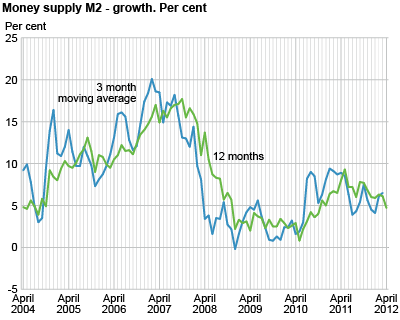Content
Published:
This is an archived release.
Decrease in money supply growth
The twelve-month growth in total money supply (M2) was 4.7 per cent to end-April, down from 6.1 per cent to end-March. All sectors contribute to the decline.
The total money supply amounted to NOK 1 718 billion at end-April, down from NOK 1 723 billion at end-March.
Decrease in money supply growth for households
Households’ money supply constitutes more than half of the total money supply. At end-April it accounted for NOK 929 billion, up from NOK 927 billion the previous month. The twelve-month growth in households’ money supply decreased from 7.7 per cent to end-March to 7.3 per cent to end-April.
The growth in households’ money supply was higher than the growth in households’ gross domestic debt, which amounted to 6.8 per cent to end-April, according to the credit indicator C2 . For more information on the financial position of households, see the financial accounts in the national accounts .
Decrease in the money supply growth for non-financial enterprises
Non-financial enterprises’ money supply amounted to NOK 540 billion at end-April, down from NOK 549 billion at end-March. The twelve-month growth decreased from 3.7 per cent to end-March to 1.2 per cent to end-April. Non-financial enterprises’ money supply constituted about 31 per cent of the total money supply and approximately 41 per cent of their gross domestic debt measured by the credit indicator C2 at end-April.
Decrease in the money supply growth for municipal government
Municipal government’s money supply amounted to NOK 74 billion at end-April, up from NOK 72 billion the previous month. The twelve-month growth rate decreased from 7.3 per cent to end-March to 5.4 per cent to end-April.
Decrease in the growth for other financial enterprises
Other financial enterprises’ money supply amounted to NOK 176 billion at end-April, up from NOK 175 billion at end-March. The twelve-month growth was 0.9 per cent to end-April, down from 4.5 per cent the previous month.
| October2011 | November 2011 | December 2011 | January 2012 | February 2012 | March 2012 | April 2012 | |||||||||||||||||||||||||||||||||||||||||||||||||||||||||||||||||||||||||
|---|---|---|---|---|---|---|---|---|---|---|---|---|---|---|---|---|---|---|---|---|---|---|---|---|---|---|---|---|---|---|---|---|---|---|---|---|---|---|---|---|---|---|---|---|---|---|---|---|---|---|---|---|---|---|---|---|---|---|---|---|---|---|---|---|---|---|---|---|---|---|---|---|---|---|---|---|---|---|---|
| M0 - 12 mth. | 53.9 | 28.1 | 9.8 | 35.9 | -5.1 | -13.8 | -0.4 | ||||||||||||||||||||||||||||||||||||||||||||||||||||||||||||||||||||||||
| M1 - 12 mth. | 7.9 | 5.9 | 4.6 | 5.6 | 5.6 | 5.9 | 3.7 | ||||||||||||||||||||||||||||||||||||||||||||||||||||||||||||||||||||||||
| M2 - 12 mth. | 7.7 | 6.8 | 6.0 | 5.9 | 6.3 | 6.1 | 4.7 | ||||||||||||||||||||||||||||||||||||||||||||||||||||||||||||||||||||||||
| M2 - 3 mth. moving average1 | 7.5 | 5.6 | 4.5 | 4.1 | 6.1 | 6.5 | |||||||||||||||||||||||||||||||||||||||||||||||||||||||||||||||||||||||||
| M2 households - 12 mth. | 5.8 | 6.6 | 7.5 | 7.3 | 7.3 | 7.7 | 7.3 | ||||||||||||||||||||||||||||||||||||||||||||||||||||||||||||||||||||||||
| M2 non-financial enterprises - 12 mth. | 8.8 | 5.3 | 4.5 | 3.5 | 4.7 | 3.7 | 1.2 | ||||||||||||||||||||||||||||||||||||||||||||||||||||||||||||||||||||||||
| 1 | Annualised figure. |
Composition of money supply
The broad monetary aggregate M2 amounted to NOK 1 718 billion at end-April, of which the major part, 91.7 per cent, consisted of bank deposits. In comparison, notes and coins only accounted for 2.6 per cent. The rest of the broad monetary aggregate consisted of shares in money market funds and certificates of deposits, which accounted for 5.5 and 0.2 per cent respectively.
Base money decrease
Base money (M0) amounted to NOK 86 billion at end-April, down from NOK 93 billion the previous month. The twelve-month growth in M0 increased from -13.8 per cent to end-March to -0.4 per cent to end-April.
New institutional sector classificationThe Norwegian institutional sector classification was revised on 1 January 2012 in line with the international classification. This change entails a break in the statistics for the money supply (M2) from March 2012. As a result of the new classification, a number of enterprises that were previously classified as non-financial enterprises are now classified as financial enterprises. In addition, some private quasi-unincorporated enterprises that were previously in the household sector are now classified as non-financial enterprises. Consequently, the new sector classification will not have an impact on the total M2, but rather on the distribution within the money holding sector. Based on data from the relevant enterprises, Statistics Norway has estimated and corrected transactions and growth rates. However, it should be noted that there is some uncertainty associated with the changes in sector classification between February 2012 and March 2012. For further information, see " Institutional sector classification 2012 ". |
The statistics is published with Monetary aggregates.
Contact
-
Statistics Norway's Information Centre
E-mail: informasjon@ssb.no
tel.: (+47) 21 09 46 42

